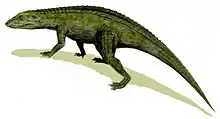Gorgetosuchus
Gorgetosuchus is an extinct genus of aetosaur from the Late Triassic of the eastern United States, represented by the type species Gorgetosuchus pekinensis. G. pekinensis was named and described by Heckert et al. (2015) on the basis of ten rows of bony plates called osteoderms, representing the front part of an armored carapace that would have covered the back of the animal. These plates were found embedded in sandstone and conglomerate boulders near a brick quarry in Chatham County, North Carolina, which likely originated from the Late Triassic Pekin Formation. (The Pekin Formation consists of interbedded red mudstones, siltstones, sandstones and conglomerates; it was the fine-grained mudstones and siltstones that the mining operation was targeting for brick-making, so coarser-grained blocks were removed from the pit). Gorgetosuchus was part of a diverse faunal community in a continental rift valley system during the Late Triassic, which also included traversodontids, phytosaurs, dicynodonts, and temnospondyls. Gorgetosuchus coexisted with two other aetosaurs, Lucasuchus and Coahomasuchus.[1]
| Gorgetosuchus | |
|---|---|
| Scientific classification | |
| Kingdom: | Animalia |
| Phylum: | Chordata |
| Class: | Reptilia |
| Order: | †Aetosauria |
| Family: | †Stagonolepididae |
| Subfamily: | †Desmatosuchinae |
| Genus: | †Gorgetosuchus Heckert et al., 2015 |
| Type species | |
| †Gorgetosuchus pekinensis Heckert et al., 2015 | |
Gorgetosuchus is unique among aetosaurs in having cervical (neck) osteoderms that nearly wrap around the entire neck and are strongly angled to give the neck a hexagonal shape in cross-section. The lateral (side) and paramedian (upper) osteoderms each bear prominent spines. Other aetosaurs such as Longosuchus also have neck spines, but only on the lateral osteoderms. The cervical osteoderms are wider than they are long, a feature that unites Gorgetosuchus with the most basal ("primitive") aetosaurs. However, several features of the osteoderms (such as a flange on the lateral cervical osteoderms that overlaps the paramedian osteoderms) link it with the desmatosuchines, a more derived group of aetosaurs. Among aetosaurs Gorgetosuchus most closely resembles Lucasuchus and Longosuchus, both of which are desmatosuchines. A phylogenetic analysis conducted by Heckert et al. placed Gorgetosuchus close to these taxa, but the results were not statistically well supported. Below is a strict consensus tree from their analysis showing the placement of Gorgetosuchus:[1]
| ||||||||||||||||||||||||||||||||||||||||||||||||||||||||||||||||||||||||||||||||||||||||||||||||||||||||||||||||
References
- Heckert, A. B.; Schneider, V. P.; Fraser, N. C.; Webb, R. A. (2015). "A new aetosaur (Archosauria, Suchia) from the Upper Triassic Pekin Formation, Deep River Basin, North Carolina, U.S.A., and its implications for early aetosaur evolution". Journal of Vertebrate Paleontology. 35: e881831. doi:10.1080/02724634.2014.881831.

